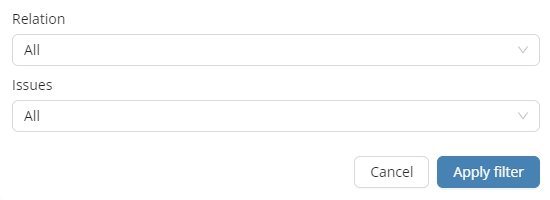Concept Maps
Concept Maps are collections of terminology mappings where components from different Code Systems are linked together.
A Concept Map is defined by the Source Domain that determines the map sources, and by the Target Domain that provides the potential map targets.
Browsing
Mappings that are part of the Concept Map can be browsed after navigating to the Content tab.

This tab displays the latest published set of mappings of the Concept Map in a table form. The search bar at the top of the table eases looking for specific mappings using term search, while the advanced filter also enables restricting the content based on the Relation type and Mappings with issues.

Once the required filters are selected, pressing ![]() will restrict the list to the matching resources.
will restrict the list to the matching resources.
The table header advises users on the Source and Target Domains involved in the Concept Map, along with their versions. Besides the domain details, the header also displays information about the total number of mappings, as well as the number of unmapped concepts.
Editing
On the Content tab of a Concept Map, users with Write permission can change the mappings by pressing the ![]() button in the upper right corner, which navigates users to the Concept Map's latest editable version.
button in the upper right corner, which navigates users to the Concept Map's latest editable version.
Quick Link
Snowray's quick link feature enables users to take a look at the referenced concepts of a Concept Map without interrupting their authoring flow.
When hovering over concepts in the mapping table or the terminology tree, the icon representing the Open in new tab option will appear.
Was this helpful?
